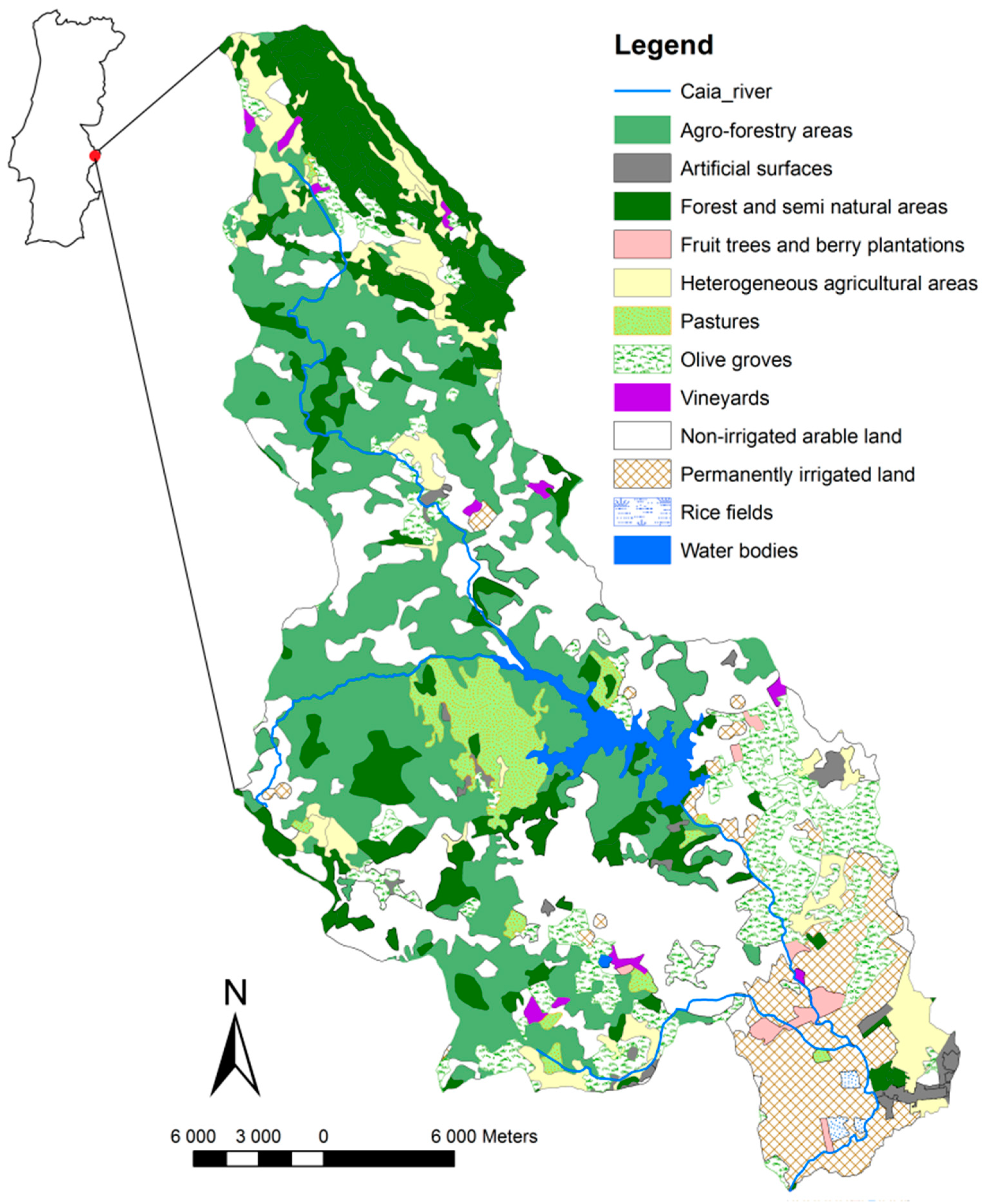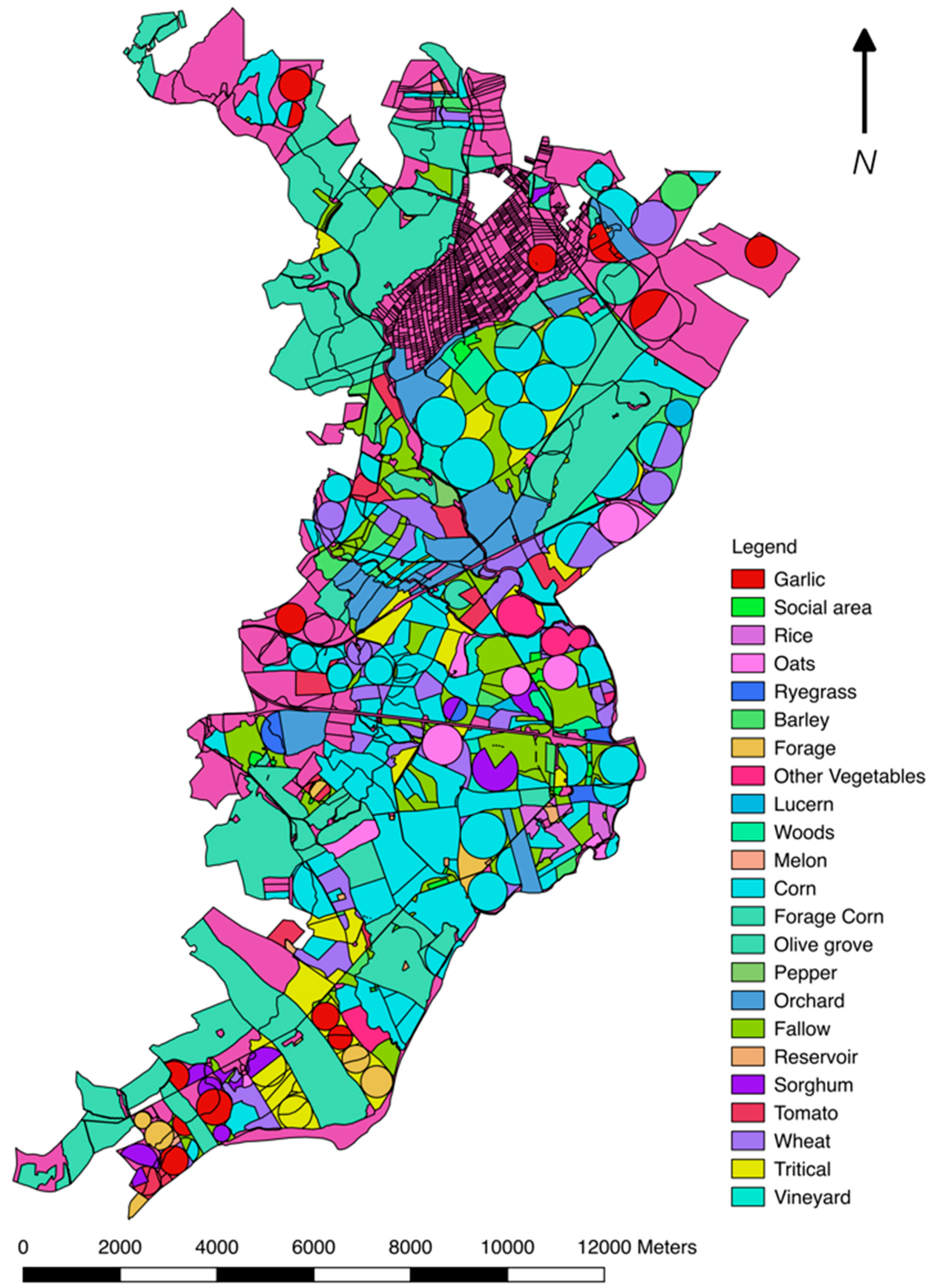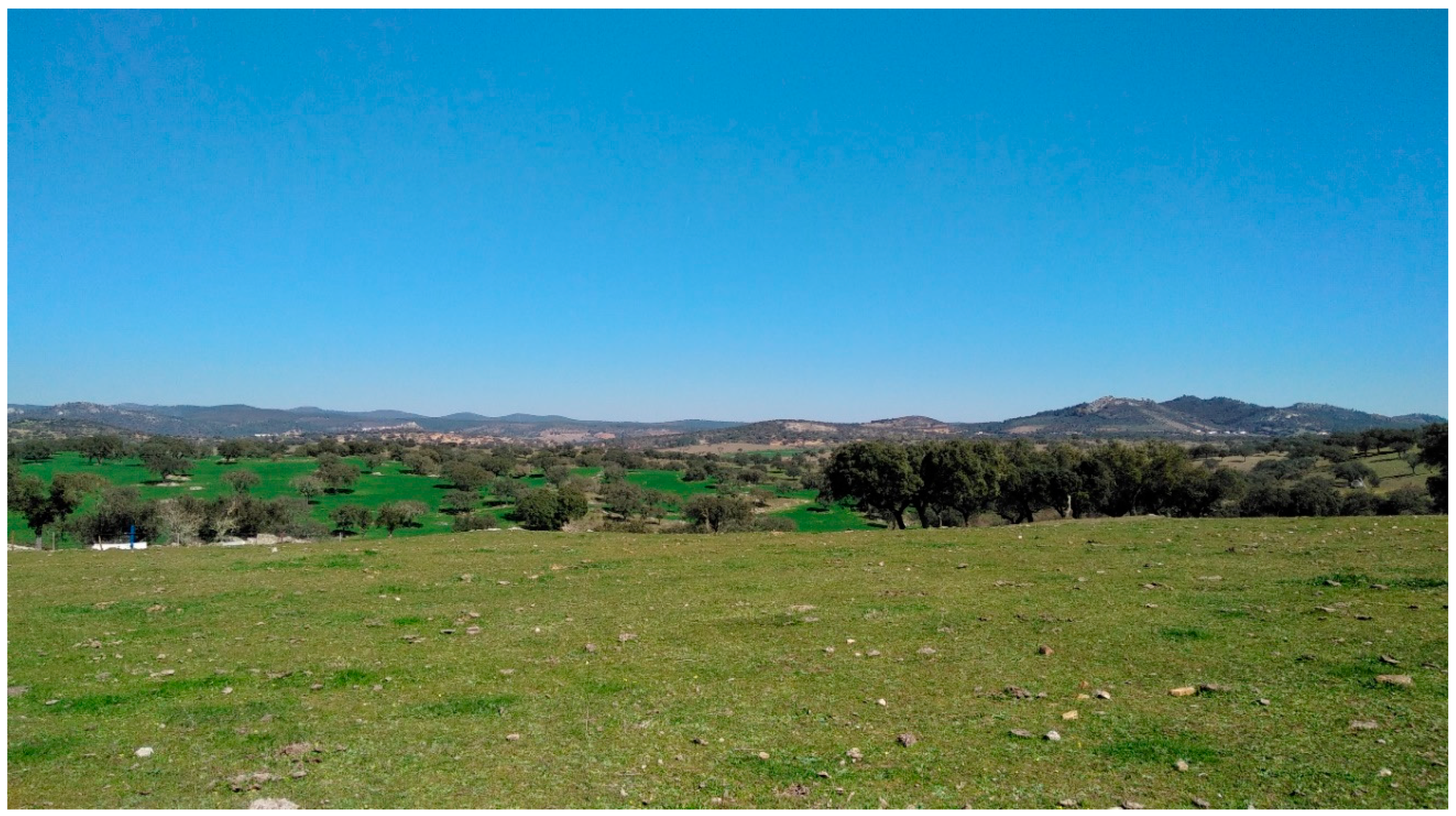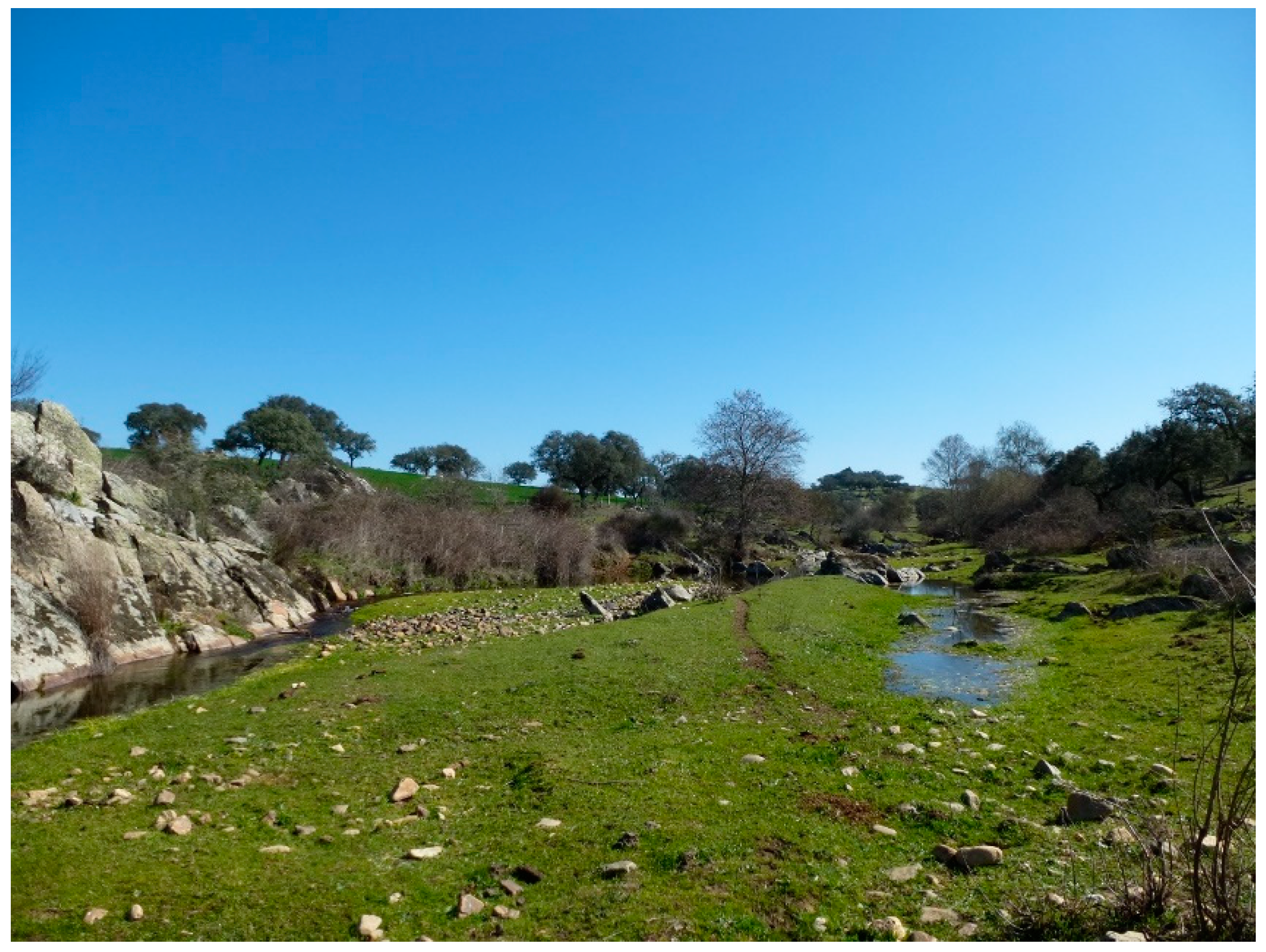Relevance of Intermittent Rivers and Streams in Agricultural Landscape and Their Impact on Provided Ecosystem Services—A Mediterranean Case Study
Abstract
:1. Introduction
2. Materials and Methods
2.1. Classification of IRES ES and Their Impact
2.2. Case Study Area
3. Results
3.1. Interactions of IRES with the Agricultural Landscape
3.2. Benefits to Agriculture from the Caia River
3.3. Agricultural Stressors to the Caia River
4. Discussion
5. Conclusions
Author Contributions
Funding
Conflicts of Interest
References
- Bennett, A.F.; Radford, J.Q.; Haslem, A. Properties of land mosaics: Implications for nature conservation in agricultural environments. Biol. Conserv. 2006, 133, 250–264. [Google Scholar] [CrossRef]
- Zhang, W.; Ricketts, T.H.; Kremen, C.; Carney, K.; Swinton, S.M. Ecosystem services and dis-services to agriculture. Ecol. Econ. 2007, 64, 253–260. [Google Scholar] [CrossRef] [Green Version]
- Power, A.G. Ecosystem services and agriculture: Tradeoffs and synergies. Philos. Trans. R. Soc. Lond. B 2010, 365, 2959–2971. [Google Scholar] [CrossRef] [PubMed]
- Bennett, E.M.; Peterson, G.D.; Gordon, L.J. Understanding relationships among multiple ecosystem services. Ecol. Lett. 2009, 12, 1394–1404. [Google Scholar] [CrossRef] [PubMed]
- Márquez, C.; García, V.; Schultz, R.; Isenhart, T. Assessment of Soil Aggradation through Soil Aggregation and Particulate Organic Matter by Riparian Switchgrass Buffers. Agronomy 2017, 7, 76. [Google Scholar] [CrossRef]
- Xu, H.; Bi, H.; Gao, L.; Yun, L. Alley Cropping Increases Land Use Efficiency and Economic Profitability Across the Combination Cultivation Period. Agronomy 2019, 9, 34. [Google Scholar] [CrossRef]
- Millennium Ecosystem Assessment. Ecosystems and Human Well-Being: Synthesis. Preface and Summary for Decision-Makers; Island Press: Washington, DC, USA, 2005. [Google Scholar]
- Haines-Young, R.; Potschin, M.B. Common International Classification of Ecosystem Services 261 (CICES): Consultation on Version 4, August–December 2012; Report to the European Environment 262 Agency; University of Nottingham: Nottingham, UK, 2013. [Google Scholar]
- Alexander, J.; Venterea, R.; Baker, J.; Coulter, J. Kura Clover Living Mulch: Spring Management Effects on Nitrogen. Agronomy 2019, 9, 69. [Google Scholar] [CrossRef]
- Trevisan, S.; Manoli, A.; Quaggiotti, S. A Novel Biostimulant, Belonging to Protein Hydrolysates, Mitigates Abiotic Stress Effects on Maize Seedlings Grown in Hydroponics. Agronomy 2019, 9, 28. [Google Scholar] [CrossRef]
- Burkhard, B.; Kroll, F.; Nedkov, S.; Müller, F. Mapping ecosystem service supply, demand and budgets. Ecol. Indic. 2012, 21, 17–29. [Google Scholar] [CrossRef]
- Schipanski, M.E.; Barbercheck, M.; Douglas, M.R.; Finney, D.M.; Haider, K.; Kaye, J.P.; Kemanian, A.R.; Mortensen, D.A.; Ryan, M.R.; Tooker, J.; et al. A framework for evaluating ecosystem services provided by cover crops in agroecosystems. Agric. Syst. 2014, 125, 12–22. [Google Scholar] [CrossRef]
- Frélichová, J.; Fanta, J. Ecosystem service availability in view of long-term land-use changes: A regional case study in the Czech Republic. Ecosyst. Health Sustain. 2015, 1, 1–15. [Google Scholar] [CrossRef]
- Brauman, K.A.; Daily, G.C.; Duarte, T.K.; Mooney, H.A. The nature and value of ecosystem services: An overview Highlighting hydrologic services. Annu. Rev. Environ. Reseur. 2007, 32, 67–98. [Google Scholar] [CrossRef]
- Grizzetti, B.; Lanzanova, D.; Liquete, C.; Reynaud, A.; Cardoso, A.C. Assessing water ecosystem services for water resource management. Environ. Sci. Policy 2016, 61, 194–203. [Google Scholar] [CrossRef]
- Špulerová, J.; Štefunková, D.; Dobrovodská, M.; Kolektiv, M.A. Historické Štruktúry Poľnohospodárskej Krajiny Slovenska; Veda: Bratislava, Slovakia, 2017; ISBN 978-80-224-1570-5. [Google Scholar]
- Van Oijen, M.; Bellocchi, G.; Höglind, M. Effects of Climate Change on Grassland Biodiversity and Productivity: The Need for a Diversity of Models. Agronomy 2018, 8, 14. [Google Scholar] [CrossRef]
- Ziska, L.; Bradley, B.; Wallace, R.; Bargeron, C.; LaForest, J.; Choudhury, R.; Vega, F. Climate Change, Carbon Dioxide, and Pest Biology, Managing the Future: Coffee as a Case Study. Agronomy 2018, 8, 152. [Google Scholar] [CrossRef]
- Gao, J.; Li, F.; Gao, H.; Zhou, C.; Zhang, X. The impact of land-use change on water-related ecosystem services: A study of the Guishui River Basin, Beijing, China. J. Clean. Prod. 2017, 163, S148–S155. [Google Scholar] [CrossRef]
- Acuña, V.; Datry, T.; Marshall, J.; Barceló, D.; Dahm, C.N.; Ginebreda, A.; McGregor, G.; Sabater, S.; Tockner, K.; Palmer, M.A. Why Should We Care About Temporary Waterways? Science 2014, 343, 1080–1081. [Google Scholar] [CrossRef] [PubMed]
- Hassan, M.A.; Egozi, R. Impact of wastewater discharge on the channel morphology of ephemeral streams. Earth Surf. Proc. Land. 2001, 26, 1285–1302. [Google Scholar] [CrossRef]
- Stubbington, R.; England, J.; Wood, P.J.; Sefton, C.E.M. Temporary streams in temperate zones: Recognizing, monitoring and restoring transitional aquatic-terrestrial ecosystems. WIREs Water 2017, e1223. [Google Scholar] [CrossRef]
- Kertész, A.; Nagy, L.A.; Balász, B. Effect of land use change on ecosystem services in Lake Balaton Catchment. Land Use Policy 2019, 80, 430–438. [Google Scholar] [CrossRef]
- Pyrce, R.S. Considering Baseflow as a Low Flow or Instream Flow; WSC Report No.04-2004 Appendix; Watershed Science Centre: Peterborough, ON, Canada, 2004; p. 17. [Google Scholar]
- Maes, J.; Liquete, C.; Teller, A.; Erhard, M.; Paracchini, M.L.; Barredo, J.I.; Meiner, A. An indicator framework for assessing ecosystem services in support of the EU Biodiversity Strategy to 2020. Ecosyst. Serv. 2016, 17, 14–23. [Google Scholar] [CrossRef]
- Guswa, A.J.; Hamel, P.; Dennedy-Frank, P.J. Potential effects of landscape change on water supplies in the presence of reservoir storage. Water Resour. Res. 2017, 53, 2679–2692. [Google Scholar] [CrossRef] [Green Version]
- Nguyen, T.P.L.; Mula, L.; Cortignani, R.; Seddaiu, G.; Dono, G.; Virdis, S.G.; Pasqui, M.; Roggero, P.P. Perceptions of Present and Future Climate Change Impacts on Water Availability for Agricultural Systems in the Western Mediterranean Region. Water 2016, 8, 523. [Google Scholar] [CrossRef]
- Datry, T.; Boulton, A.J.; Bonada, N.; Fritz, K.; Leigh, C.; Sauquet, E.; Tockner, K.; Hugueny, B.; Dahm, C.N. Flow intermittence and ecosystem services in rivers of the Anthropocene. J. Appl. Ecol. 2017, 1–12. [Google Scholar] [CrossRef]
- Sánchez-Montoya, M.M.; Moleón, M.; Sánchez-Zapata, J.A.; Tockner, K. Dry riverbeds: Corridors for terrestrial vertebrates. Ecosphere 2016, 7, e01508. [Google Scholar] [CrossRef]
- Steward, A.L.; Marshall, J.C.; Sheldon, F.; Harch, B.; Choy, S.; Bunn, S.E.; Tockner, K. Terrestrial invertebrates of dry riverbeds are not simply subsets of riparian assemblages. Aquat. Sci. 2011, 73, 551–566. [Google Scholar] [CrossRef]
- Cooper, S.M.; Perotto-Baldivieso, H.L.; Owens, M.K.; Meek, M.G.; Figueroa-Pagán, M. Distribution and interaction of white-tailed deer and cattle in a semi-arid grazing system. Agric. Ecosyst. Environ. 2008, 127, 85–92. [Google Scholar] [CrossRef]
- Loures, L.; Gama, J.; Nunes, J.; Lopez-Piñeiro, A. Assessing the Sodium Exchange Capacity in Rainfed and Irrigated Soils in the Mediterranean Basin Using GIS. Sustainability 2017, 9, 405. [Google Scholar] [CrossRef]
- FAO; IFAD; UNICEF; WFP; WHO. The State of Food Security and Nutrition in the World 2018. Building Climate Resilience for Food Security and Nutrition; FAO: Rome, Italy, 2018. [Google Scholar]
- Layke, C.; Mapendembe, A.; Brown, C.; Walpole, M.; Winn, J. Indicators from the global and sub-global Millennium Ecosystem Assessments: An analysis and next steps. Ecol. Indic. 2012, 17, 77–87. [Google Scholar] [CrossRef]
- Larned, S.T.; Datry, T.; Arscott, D.B.; Tockner, K. Emerging Concepts in Temporary-River Ecology. Freshw. Biol. 2010, 55, 717–738. [Google Scholar] [CrossRef]
- Koundouri, P.; Boulton, J.A.; Datry, T.; Souliotis, I. Ecosystem services, values, and societal perceptions of intermittent rivers and ephemeral streams. In Intermittent Rivers and Ephemeral Streams; Academic Press: Cambridge, MA, USA, 2017; pp. 455–476. [Google Scholar]
- OTALEX-C. ATLAS, OTALEX-C. In Direccíon General de Transportes, Ordenación del Territorio e Urbanismo. Consejeria de Fomento, Vivienda, Ordenación del Territorio y Turismo; Junta de Extyremadura: Merida, Spain, 2013. [Google Scholar]
- Agência Portuguesa do Ambiente. Plano de Gestão de Região Hidrográfica. Região Hidrográfica do Guadiana (RH7). 2015. Available online: www.apambiente.pt (accessed on 3 January 2019).
- Caldas, J.C.; Sousa, P.L.; Pereira, L.S. Need for new approaches in valuing water: Learning from a less successful case. In Water: Economics, Management and Demand; Kay, M., Franks, T., Smith, L.E.D., Eds.; Taylor Francis: London, UK, 1997; pp. 125–131. [Google Scholar]
- Nunes, J.; Loures, L. Contributos para a Sustentabilidade do Regadio a Sul do Tejo; Instituto Politécnico de Portalegre: Portalegre, Portugal, 2013. [Google Scholar]
- Siebert, S.F. Traditional agriculture and the conservation of biological diversity in Crete, Greece. Int. J. Agric. Sustain. 2004, 2, 109–117. [Google Scholar] [CrossRef]
- Amuti, T.; Luo, G.; Yin, G.; Hu, Q.; Walter-Shea, E. Validation of a Process-Based Agro-Ecosystem Model (Agro-IBIS) for Maize in Xinjiang, Northwest China. Agronomy 2018, 8, 29. [Google Scholar] [CrossRef]
- WebGIS of Hotspot Areas for Biodiversity and Ecosystem Services. 2018. Available online: http://www.habeas-med.org/wwf_webgis/lizmap/www/index.php/view/map/?repository=habeas,project=habeas_2_0 (accessed on 10 February 2018).
- Pires, A.M.; Cowx, I.G.; Coelho, M.M. Life history strategy of Leuciscus pyrenaicus (cyprinidae) in intermittent streams of the Guadiana basin (Portugal). Cybium 2000, 24, 287–297. [Google Scholar]
- Associação de Regantes e Beneficiários do Vale do Sorraia. Bases De Lancamento Para a Campanha 2016; Circular Campanha Rega No. 1; Associação de Regantes e Beneficiários do Vale do Sorraia: Coruche, Portugal, 2016. [Google Scholar]
- Haygarth, P.M.; Jarvis, S.C. Agriculture, Hydrology and Water Quality; CABI Publishing: Oxon, UK, 2002; p. 499. [Google Scholar]
- Wood, A.; van Halsema, G.E. Scoping Agriculture–Wetland Interactions; FAO: Italy, Rome, 2008. [Google Scholar]
- Tian, Y.; Zheng, Y.; Wu, B.; Wu, X.; Liu, J.; Zheng, C. Modeling surface water-groundwater interaction in arid and semi-arid regions with intensive agriculture. Environ. Model. Softw. 2015, 63, 170–184. [Google Scholar] [CrossRef]
- Benayas, J.M.R.; Bullock, J.M. Restoration of Biodiversity and Ecosystem Services on Agricultural Land. Ecosystems 2012, 15, 883–899. [Google Scholar] [CrossRef]
- Momblanch, A.; Paredes-Arquiola, J.; Andreu, J. Improved modelling of the freshwater provisioning ecosystem service in water scarce river basins. Environ. Model. Softw. 2017, 94, 87–99. [Google Scholar] [CrossRef] [Green Version]
- Balbi, S.; del Prado, A.; Gallejones, P.; Pappachan Geevan, C.; Pardo, G.; Pérez-Miñana, E.; Manrique, R.; Hernandez-Santiago, C.; Villa, F. Modeling trade-offs among ecosystem services in agricultural production systems. Environ. Model. Softw. 2015, 72, 314–326. [Google Scholar] [CrossRef] [Green Version]
- Jurík, Ľ.; Kaletová, T. Base flow and drought in landscape. In Voda, Izmenenje Klimata i Zdorovje Celoveka: Materialy Dokladov Mezdunarodnogo Molodeznogo Foruma, Minsk, 25–26 Nojabrja 2009 Goda; Baraksin A. H: Minsk, Belarus, 2010; pp. 110–119. [Google Scholar]
- Jorda-Capdevila, D.; Rodríguez-Labajos, B. An ecosystem service approach to understand conflicts on river flows: Local views on the Ter River (Catalonia). Sustain. Sci. 2015, 10, 463–477. [Google Scholar] [CrossRef]
- Sulis, M.; Marrocu, M.; Paniconi, C. Conjunctive Use of a Hydrological Model and a Multicriteria Decision Support System for a Case Study on the Caia Catchment, Portugal. J. Hydrol. Eng. 2009, 14, 141–152. [Google Scholar] [CrossRef]
- Falkenmark, M. Growing water scarcity in agriculture: Future challenge to global water security. Phil. Trans. R. Soc. A 2013, 371, 20120410. [Google Scholar] [CrossRef]
- Šurda, P.; Kaletová, T.; Rodný, M. Vplyv struktury polnohospodarskeho porastu na vysku povrchoveho odtoku v ramci povodia. Acta Hydrol. Slovaca 2013, 14, 30–36. [Google Scholar]
- Von Haden, A.; Dornbush, M. Prairies Thrive Where Row Crops Drown: A Comparison of Yields in Upland and Lowland Topographies in the Upper Midwest US. Agronomy 2016, 6, 32. [Google Scholar] [CrossRef]
- Kubinský, D.; Weis, K.; Fuska, J.; Lehotský, M.; Petrovič, F. Changes in retention characteristics of 9 historical artificial water reservoirs near Banská Štiavnica, Slovakia. Open Geosci. 2015, 7, 880–887. [Google Scholar]
- Sheshukov, A.Y.; Sekaluvu, L.; Hutchinson, S.L. Accuracy of topographic index models at identifying ephemeral gully trajectories on agricultural fields. Geomorphology 2018, 306, 224–234. [Google Scholar] [CrossRef]
- Keesstra, S.D.; Kondrlová, E.; Czajka, A.; Seeger, M.; Maroulis, J. Assessing riparian zone impacts on water and sediment movement: A new approach. Neth. J. Geosci. 2012, 91, 245–255. [Google Scholar] [CrossRef]
- Steward, A.L.; von Schiller, D.; Tockner, K.; Marshall, J.C.; Bunn, S.E. When the river runs dry: Human and ecological values of dry riverbeds. Front. Ecol. Environ. 2012, 10, 202–209. [Google Scholar] [CrossRef]
- Steward, A.L.; Negus, P.; Marshall, J.C.; Clifford, S.E.; Dent, C. Assessing the ecological health of rivers when they are dry. Ecol. Indic. 2018, 85, 537–547. [Google Scholar] [CrossRef]
- Goosens, D. On-site and off-site effects of wind erosion. In Wind Erosion on Agricultural Land in Europe; Earren, A., Ed.; EUR 20370; European Commission: Brussels, Belgium, 2003; pp. 29–38. [Google Scholar]
- Van Kerckhoven, S.; van Riksen, M.; Cornelis, W. Afbakening van Gebieden Gevoelig aan Winderosie in Vlaanderen. Faculteit Bio-Ingenieurswetenschappen; Gent Universiteit: Gent, Belgium, 2009; p. 79. [Google Scholar]
- Belsky, A.J.; Matzke, A.; Uselman, S. Survey of livestock influences on stream and riparian ecosystems in the western United States. J. Soil Water Conserv. 1999, 54, 419–431. [Google Scholar]
- Gordon, L.G.; Enfors, E.I. Land degradation, ecosystem services, and resilience of smallholder farmers in Makanya catchment, Tanzania. In Conserving Land, Protecting Water; Bossio, D., Geheb, K., Eds.; CABI: London, UK, 2008; pp. 33–50. [Google Scholar]
- Hooke, J.M. Extreme sediment fluxes in a dryland flash flood. Sci. Rep. 2019, 9, 1686. [Google Scholar] [CrossRef]
- Estrela, M.; Silva, E. Guadiana basin. Water quality and the development of the Alqueva region; NeWater Project Report, FP6 Global Change and Ecosystems; ISQ: Portugal, Lisbon, 2009. [Google Scholar]
- Hasan, M.R. Nutrition and feeding for sustainable aquaculture development in the third millennium. In Aquaculture in the Third Millennium. Technical Proceedings of the Conference on Aquaculture in the Third Millennium, Bangkok, Thailand, 20–25 February 2000; Subasinghe, R.P., Bueno, P., Phillips, M.J., Hough, C., McGladdery, S.E., Arthur, J.R., Eds.; NACA, Bangkok and FAO: Rome, Italy, 2001; pp. 193–219. [Google Scholar]
- Hirel, B.; Krapp, A. Special Issue: Nitrogen Transport and Assimilation in Plants. Agronomy 2016, 6, 41. [Google Scholar] [CrossRef]
- Whitmire, S.L.; Hamilton, S.K. Rapid removal of nitrate and sulfate by freshwater wetland sediments. J. Environ. Qual. 2005, 34, 2062–2071. [Google Scholar] [CrossRef]
- Collares-Pereira, M.J.; Pires, A.M.; Coelho, M.M.; Cowx, I.G. Towards a Conservation Strategy for Anaecypris Hispanica, the most Endangered Non-Migratory Fish in PORTUGUESE Streams. Stoking and Introduction of Fish; Cowx, I.G., Ed.; Blackwell Science: Oxford, UK, 1998; pp. 437–449. [Google Scholar]





| Land Use | 1990 | 2012 | ||
|---|---|---|---|---|
| Area (ha) | Area (%) | Area (ha) | Area (%) | |
| Artificial surfaces | 513 | 0.61% | 1061.46 | 1.26% |
| Forest and semi natural areas | 10,047.79 | 11.94% | 11,695.53 | 13.89% |
| Water bodies | 1537.01 | 1.83% | 1584 | 1.88% |
| Agricultural areas (of wich): | 72,079.04 | 85.63% | 69,835.77 | 82.96% |
| Non-irrigated arable land | 31,747.02 | 37.71% | 21,293.54 | 25.30% |
| Permanently irrigated land | 4782.29 | 5.68% | 6758.42 | 8.03% |
| Rice fields | 892.24 | 1.06% | 177.64 | 0.21% |
| Vineyards | 137.46 | 0.16% | 497.12 | 0.59% |
| Fruit trees and berry plantations | 553.41 | 0.66% | 573.14 | 0.68% |
| Olive groves | 5498.86 | 6.53% | 8126.14 | 9.65% |
| Pastures | 25.97 | 0.03% | 3092.53 | 3.67% |
| Heterogeneous agricultural areas | 4407.37 | 5.24% | 5264.27 | 6.25% |
| Agroforestry areas | 24,034.42 | 28.55% | 24,052.97 | 28.57% |
| ES Provided by the Agricultural Landscape | ES Provided by IRES (a) | Impact of IRES (b) | ||||
|---|---|---|---|---|---|---|
| Flowing | Pools | Dry | Flowing | Pools | Dry | |
| Provisioning ES | ||||||
| Cultivated crops | 1 | 1 | 1 | ++ | + | + |
| Reared animals and their outputs | 2 | 1 | 1 | ++ | + | + |
| Wild plants | 2 | 1 | 1 | ++ | + | +/− |
| Wild animals and their outputs | 2 | 2 | 2 | + | + | + |
| Surface water for drinking | 2 | 1 | 0 | ++ | + | n/a |
| Ground water for drinking | 2 | 1 | 1 | ++ | ++ | n/a |
| Fibers and other materials from plants, algae and animals for direct use or processing | 2 | 2 | 2 | ++ | + | + |
| Materials from plants, algae and animals for agricultural use | 2 | 1 | 2 | ++ | + | + |
| Genetic materials from all biota | 2 | 2 | 2 | ++ | ++ | ++ |
| Surface water for non-drinking purposes | 2 | 1 | 0 | ++ | + | n/a |
| Ground water for non-drinking purposes | 2 | 1 | 1 | ++ | + | n/a |
| Plant-based resources of energy | 1 | 2 | 2 | ++ | + | + |
| Animal-based resources of energy (e.g., from manure) | 2 | 1 | 1 | ++ | + | + |
| Regulation and maintenance ES | ||||||
| Filtration/sequestration/storage/accumulation by ecosystems | 2 | 2 | 2 | ++ | + | − |
| Mediation of smell/noise, visual impacts | 2 | 1 | 1 | ++ | + | + |
| Mass stabilization and control of erosion rates | 1 | 2 | 2 | +/− | + | ++ |
| Buffering and attenuation of mass flows (e.g., sediment retention) | 1 | 2 | 2 | +/− | + | ++ |
| Hydrological cycle and water flow maintenance | 2 | 1 | 0 | n/a | n/a | n/a |
| Flood protection | 1 | 1 | 1 | n/a | n/a | n/a |
| Storm protection | n/a | n/a | n/a | n/a | n/a | n/a |
| Ventilation and transpiration | 2 | 2 | 2 | + | + | − |
| Pollination and seed dispersal | 1 | 1 | 1 | ++ | ++ | ++ |
| Maintaining nursery populations and habitats (e.g., traditional orchard) | 2 | 2 | 2 | ++ | + | + |
| Pest control | 2 | 1 | 1 | + | + | ++ |
| Disease control | 2 | 2 | 2 | +/− | + | ++ |
| Weathering processes (e.g., water and wind erosion) | 2 | 2 | 2 | + | + | + |
| Decomposition and fixing processes (e.g., gross nitrogen balance) | 2 | 2 | 2 | + | + | n/a |
| Chemical condition of freshwater | 2 | 1 | 0 | ++ | + | − |
| Global climate regulation by reduction of greenhouse gas concentrations (e.g., carbon sequestered by plants) | 2 | 1 | 0 | ++ | + | + |
| Micro and regional climate regulation | 2 | 1 | 1 | ++ | + | +/− |
| Cultural ES | ||||||
| Experiential use of plants, animals and landscapes in different environmental settings | 2 | 1 | 1 | ++ | ++ | ++ |
| Physical use of landscapes in different environmental settings | 2 | 2 | 2 | ++ | ++ | ++ |
| Scientific studies | 2 | 2 | 2 | ++ | ++ | ++ |
| Education (e.g., didactic farm) | 2 | 2 | 2 | ++ | ++ | ++ |
| Heritage, culture (e.g., monuments, certified products) | 2 | 2 | 2 | ++ | + | n/a |
| Entertainment (contest, competition) | 2 | 2 | 2 | ++ | ++ | ++ |
| Aesthetic (e.g., photos, visitors) | 2 | 2 | 2 | ++ | ++ | ++ |
| Symbolic (e.g., trees, species) | 2 | 2 | 2 | ++ | ++ | +/− |
| Sacred and/or religious (e.g., pilgrim paths, chapels) | 2 | 2 | 2 | ++ | ++ | ++ |
| Existence (protected areas, e.g., Natura 2000, UNESCO) | 2 | 2 | 2 | ++ | ++ | ++ |
| Crop | Area (ha) | WC * (m3 ha−1 year−1) | Total WC (m3 year−1) |
|---|---|---|---|
| Other Vegetables | 121.98 | 500 | 60,990 |
| Vineyard | 61.01 | 2000 | 122,020 |
| Oats | 228.02 | 600 | 136,812 |
| Barley | 211.88 | 800 | 169,504 |
| Triticale | 452.84 | 1000 | 452,840 |
| Wheat | 628.00 | 1000 | 628,000 |
| Sorghum | 161.69 | 5000 | 808,450 |
| Garlic | 287.87 | 3500 | 1,007,545 |
| Rice | 78.09 | 1,093,260 | |
| Tomato | 206.52 | 6000 | 1,239,120 |
| Orchards | 550.77 | 6500 | 3,580,005 |
| Olive grove | 2914.66 | 3000 | 8,743,980 |
| Corn | 2743.88 | 9000 | 24,694,920 |
| Benefits | Stressors |
|---|---|
| surface water | intensification and monoculture |
| ground water | soil water erosion |
| nutrition for animals | wind erosion |
| nutrients and organic matter | nutrients |
| pollinators (wild pollinators from nearby areas) | competition for resources |
| soil fertility | lack of water |
| genetic diversity | water quality |
| natural predators/parasitoids | invasive species |
| research approach | |
| soil water–air regime |
© 2019 by the authors. Licensee MDPI, Basel, Switzerland. This article is an open access article distributed under the terms and conditions of the Creative Commons Attribution (CC BY) license (http://creativecommons.org/licenses/by/4.0/).
Share and Cite
Kaletová, T.; Loures, L.; Castanho, R.A.; Aydin, E.; Gama, J.T.d.; Loures, A.; Truchy, A. Relevance of Intermittent Rivers and Streams in Agricultural Landscape and Their Impact on Provided Ecosystem Services—A Mediterranean Case Study. Int. J. Environ. Res. Public Health 2019, 16, 2693. https://doi.org/10.3390/ijerph16152693
Kaletová T, Loures L, Castanho RA, Aydin E, Gama JTd, Loures A, Truchy A. Relevance of Intermittent Rivers and Streams in Agricultural Landscape and Their Impact on Provided Ecosystem Services—A Mediterranean Case Study. International Journal of Environmental Research and Public Health. 2019; 16(15):2693. https://doi.org/10.3390/ijerph16152693
Chicago/Turabian StyleKaletová, Tatiana, Luis Loures, Rui Alexandre Castanho, Elena Aydin, José Telo da Gama, Ana Loures, and Amélie Truchy. 2019. "Relevance of Intermittent Rivers and Streams in Agricultural Landscape and Their Impact on Provided Ecosystem Services—A Mediterranean Case Study" International Journal of Environmental Research and Public Health 16, no. 15: 2693. https://doi.org/10.3390/ijerph16152693
APA StyleKaletová, T., Loures, L., Castanho, R. A., Aydin, E., Gama, J. T. d., Loures, A., & Truchy, A. (2019). Relevance of Intermittent Rivers and Streams in Agricultural Landscape and Their Impact on Provided Ecosystem Services—A Mediterranean Case Study. International Journal of Environmental Research and Public Health, 16(15), 2693. https://doi.org/10.3390/ijerph16152693








